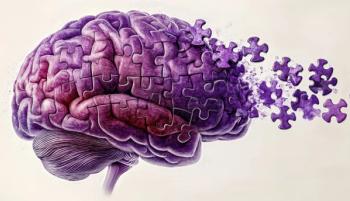
- Vol 42, Issue 11
ADHD and Mild Cognitive Impairment/Early Dementia: A Clinical Reality
Key Takeaways
- ADHD prevalence in older adults is estimated between 2.18% and 3.5%, with treatment rates significantly lower than diagnosis rates.
- Diagnosing ADHD in older adults is complex due to symptom overlap with other cognitive disorders and limited clinical training.
Let's investigate the complexities of diagnosing and treating ADHD in older adults, highlighting its prevalence, comorbidities, and treatment challenges.
SPECIAL REPORT: ADHD
Attention-deficit/hyperactivity disorder (ADHD) has been established as a lifelong neurodevelopmental disorder for the majority of individuals with childhood ADHD.1 However, there is very little understanding about the evolution of ADHD with aging and its relation to mild cognitive impairment (MCI) or early dementia. It is also expected that the population of persons older than 65 years in the United States will rise from 58 million in 2022 to 82 million by 2050—a 47% increase.2 ADHD will be one of many psychiatric contributors to morbidity in this aging population.
The validity of ADHD in adults and its continued impact in adulthood has been well demonstrated.3-7 However, these studies have not included adults beyond the fourth decade of life.8,9 The absence of clinical research also arises from the exclusion of individuals over age 65 from pharmacological trials, out of concern for mistaken inclusion of individuals with non-ADHD cognitive disorders and the challenges of exclusionary criteria for recruitment.10
The most recent population estimate of older adults with ADHD comes from a study by Dobrosavljevic et al, who analyzed 20 studies across 32 databases, with a total sample size of 20,999,871 individuals, of which 41,420 had ADHD. The estimated prevalence of ADHD in older adults was 2.18% (95% CI, 1.51-3.16), when diagnosed through validated scales in community samples, and 0.23% (95% CI, 0.06-0.15) when relying on clinical diagnoses in electronic health records. The prevalence of treatment for ADHD in older adults is much lower, at 0.09% (95% CI, 0.12-0.43), which is less than 40% of those clinically diagnosed with ADHD.11 International studies have placed the prevalence rate
of ADHD in older adults between 2.8% and 3.5%.12,13 A meta-analysis of ADHD prevalence in studies utilizing different age ranges from 18 to 74 suggests that the prevalence may decline with age.4 Prevalence rates of psychiatric disorders are also generally higher in a clinical population than in the general public.
While the literature on adult ADHD has accumulated over the past 2 decades, professional training programs in fields such as psychiatry, psychology, nursing, mental health, and primary care have had limited focus on adult ADHD. Therefore, clinicians have not been provided with the skills needed to identify, diagnose, and treat ADHD in adults, especially older patients. The absence of clinical knowledge and the presence of bias limit clinicians from reaching an accurate diagnosis of ADHD in older adults.14 Additionally, the decision to treat older adults with ADHD medications involves balancing the potential improvement in quality of life, which is often substantial, against manageable medical risks.
Diagnosis
Diagnosing ADHD in older adults with cognitive symptoms is complex, due to the large number of differential diagnoses that must be considered (
Often, clinicians will focus on the presenting cognitive symptoms and any worsening in the past months or years, thereby assuming this presentation is age related, without considering ADHD as a possible preexisting disorder. Many older adults with ADHD were not diagnosed as children, in part because ADHD was poorly recognized decades ago. In fact, 75% of the adults between 18 and 44 with ADHD in the 2006 National Comorbidity Study Replication were not diagnosed as children.15
Two components in the evaluation process present clinical challenges: differential diagnoses and coexisting disorders. The first component is the nonpathognomonic, transdiagnostic phenomenon of ADHD symptoms, such as inattention, distractibility, and impulsivity. The clinician needs to determine if inattention is impairing daily function to be clinically relevant and to which diagnostic category it is assigned. In a patient with depression and ADHD, is the inattention ascribed to the
Differential diagnoses can be broadly categorized into medical, psychiatric, and psychological factors, each further divided into chronic and acute subcategories. Medical conditions can be (1) acute (traumatic brain injury, mild delirium), (2) chronic medical issues that cause cognitive symptoms (alcohol/substance use disorder, multiple sclerosis, lupus), or (3) medications known for soft cognitive symptoms (eg, chemotherapy, topiramate, lithium, valproate, anticholinergics). For psychiatric conditions contributing to cognitive symptoms, acute disorders might manifest as a major depressive episode. In contrast, chronic psychiatric disorders could include treatment-resistant major depression or
If an older patient has lifelong ADHD and now complains of worsening cognitive symptoms over recent months or years, the questions to ask are psychiatric (Is ADHD worsening or medication tolerance developing?), psychological (Have environmental demands increased or a support has been lost?), and medical (Is there another medical process occurring?).
Neuropsychological testing to diagnose or differentiate ADHD from other cognitive difficulties in older adults is not helpful. Normal performance across several measures has been observed in adults with ADHD over the age of 60.17 While there may be deficits on some neuropsychological tests in older adults with ADHD, for example, response inhibition on the Stroop task, there appears to be no consistent pattern of deficits in this population of patients.18 Given these results, it may be premature to recommend using neuropsychological testing for diagnosis differentiation. Any neuropsychological test results must be interpreted within the clinical context and history of symptoms.
There are several validated symptom scales for adult ADHD, and the most common clinically used scales are the Adult ADHD Self-Report Scale (6-item screener) and the 18-item symptom checklist.19 Although 3 scales (Wender Utah Rating Scale, Barkley Childhood and Current Symptoms Scales) have been studied in individuals with ADHD between the ages of 65 and 80, they are proprietary and not widely used in clinical practice.20 Recall bias of childhood symptoms or impairments in older adults can be mitigated by collateral information to document the chronicity of symptoms and impairments.
Differential Diagnosis
The term mild cognitive impairment has now
been renamed mild neurocognitive disorder (MND) in the DSM-5. DSM-5 criteria for MND are (1) evidence of modest cognitive decline in one or more cognitive domains based on concern of the individual, a knowledgeable informant, or clinician or impairment on standardized neuropsychological testing, (2) cognitive deficits do not interfere with independence, and (3) another mental disorder does not better explain the deficits.21 While many of the cognitive symptoms of ADHD and MND overlap, MND has some distinct deficits not typically seen in ADHD that may be detected on specific neuropsychological tests. Semantic deficits are more specific to MND and manifest as word retrieval, misspelling, word substitution, and the use of things or stuff as generic descriptors. These semantic deficits can appear in dementias, stroke, and traumatic brain injury, but are not typically seen in ADHD.22 In a clinical interview, word retrieval, word substitution, and generic use of things or stuff can be evident, and/or it can be queried along with word misspelling.
Older adults presenting with cognitive difficulties may have symptoms ascribed as an age-related element in an evaluation, without assessing the premorbid cognitive status. The reported symptoms can be long-standing ADHD, new-
onset age-related decline, or MND. Given the heterogeneity of ADHD and MND, many symptoms overlap, making it difficult to distinguish one disorder from the other on a cross-sectional evaluation of symptoms. The onset of such symptoms in childhood and the chronic nature of symptoms over a lifetime would strongly suggest ADHD. However, what if the patient with ADHD states that the symptoms have worsened over the past 2 to 3 years? Does ADHD get worse with age? No evidence currently supports that. Therefore, is there a second process in development? Are patients with ADHD at risk of developing dementia? Can the 2 disorders coexist in a patient? How would you tell them apart during the evaluation?
The second component complicating the diagnostic process is the frequent concurrent psychiatric and medical disorders that must be distinguished during the evaluation. The cross-sectional assessment of cognitive and behavioral symptoms is not an optimal or accurate method for distinguishing ADHD and coexisting disorders because of the transdiagnostic nature of individual symptoms. While the array of presenting symptoms necessitates consideration of differential diagnoses, clinical conclusions are seldom binary—often involving the possibility of contemporaneous processes. The presence of concurrent disorders that both manifest cognitive symptoms may additively compound cognitive deficits. In addition to psychiatric comorbidity confounders, concurrent medical disorders (such as autoimmune disorders, previous brain trauma, connective tissue disorders, MND, dementia, and perimenopause) may also cause cognitive difficulties, which may explain the presenting cognitive difficulties or exacerbate cognitive symptoms of ADHD. Also, medications for medical and/or psychiatric disorders may cause cognitive symptoms. In adults over age 65, studies indicate that two-thirds of older individuals are prescribed at least 3 medications.23
Cognitive complaints from older adults will likely prompt a clinician to pursue a medical or neurological workup to rule out etiologies. A neurodegenerative disorder becomes a concern, with recent epidemiological studies linking ADHD with subsequent neurodegenerative disorders such as Alzheimer dementia, Lewy body dementia, Parkinson disease, and basal ganglia/cerebellar diseases.24-27 With worsening cognitive symptoms, a workup for
Comorbidities in Older Adults
Psychiatric comorbidities are common among both younger and older adults with ADHD. A prospective study from the Netherlands of 203 controls and 23 participants with ADHD with a mean age of 71 found higher rates of depression and anxiety, lower self-esteem, and a lower sense of mastery.28 A small US study of 27 patients from psychiatric practices demonstrated higher rates of depression, anxiety, and
Pharmacologic Treatments
There is a paucity of pharmacologic research on the use of ADHD medications in patients over age 65. Published research is very limited on efficacy trials, tolerability, and safety assessments because the age limit of most clinical trials is 65. The number of participants over the age of 50 in these trials is likely to have been relatively small as well because of standard exclusion criteria for physical illness and medications. The age limit for Food and Drug Administration (FDA)–approved ADHD medications for adults is 65, except for lisdexamfetamine, which has a limit of age 55; the prescription of ADHD medications to patients over 65 is considered off-label.
In general, it is established that ADHD medications (stimulants and nonstimulants) have the risk for variable elevations in blood pressure and pulse that necessitate clinical monitoring in patients. Elmer and colleagues assessed safety parameters for lisdexamfetamine in subjects aged 55 to 84 years. However, investigators concluded that no pulse and blood pressure trends were seen by age.31 For a minority of adults, stimulant treatment will elevate blood pressure levels that warrant clinical action. It should be noted that ADHD has been demonstrated to be an independent risk factor for cardiovascular disease, and the hazard ratio is higher in younger adults (HR, 2.49; ages 18-30) than older adults (HR, 1.22; ages 61-73).32 This association is not widely known among clinicians prescribing these medications to older adults.
Efficacy and tolerability have not been established in randomized controlled trials for older adults with ADHD. A post hoc analysis of a randomized, placebo-controlled trial with a multilayer, extended-release methylphenidate preparation in adult ADHD looked at subjects aged 50 to 72 (mean age, 56.1±5.0). The results demonstrated improvement on the ADHD-5 Rating Scale Total Score relative to placebo. The most frequent adverse events were insomnia and headache.33 A survey from Norway of 149 adults with ADHD over age 50 reported that 63.8% were currently prescribed ADHD medication, while 23% reported no ADHD medication. Patients taking ADHD medication reported better attention and ability to manage daily demands than those without medication. The study also found that using an extended-release methylphenidate formulation predicted longer treatment duration.30 Two smaller observational studies of older adults with ADHD reported improvements in symptoms with stimulant medication and no serious adverse effects.29,34 There are no published studies using atomoxetine or viloxazine for the treatment of ADHD in older adults.
Regarding stimulant treatment in MCI, there is a small (n = 15) 3-day randomized, double-blind, placebo-controlled trial with methylphenidate, involving participants with a mean age of 76±6.6 years. At a maximum daily dose of 30 mg on day 3, there was a significant improvement in nonverbal memory but not verbal memory.35 In the American Academy of Neurology’s article “Practice Guideline Update Summary: Mild Cognitive Impairment” from 2018, there is no listing of methylphenidate or amphetamine as treatment for MCI because of the absence of published literature.36
Nonpharmacologic Therapies
There is just 1 randomized 12-week cognitive behavioral therapy trial comparing adults with ADHD aged 50 and older (n = 26) with younger adults (n = 55). In this trial, both groups responded equally well to the measures of attention. The older group responded as well to support as they did to cognitive behavioral therapy on several outcome measures.37 Research on useful therapeutic approaches for these individuals is needed.
Concluding Thoughts
ADHD is a necessary consideration in the differential diagnosis of older adults seeking an evaluation for cognitive difficulties. Diagnostic challenges of differential diagnosis, coexisting disorders, diagnostic prioritization, and treatment sequencing require clinical acumen.
Current preliminary publications and research suggest that stimulant medication is effective in reducing ADHD symptoms with manageable adverse events in older adults; the improvement in subjective functioning and quality of life merits the treatment. In cases of concurrent ADHD and mild neurocognitive disorder/early dementia, the diagnostic prioritization for treatment would suggest the treatment of ADHD first and then reassess the residual cognitive deficits for adjunctive treatment.
In summary, this population is fertile ground for much-needed research to address an aging ADHD population that, with treatment, would be better able to maintain a higher level of function and quality of life.
Dr Goodman is an assistant professor in the Department of Psychiatry and Behavioral Sciences at Johns Hopkins School of Medicine and a clinical associate professor in the Department of Psychiatry at Norton College of Medicine at SUNY Upstate Medical University. He is also the founder of the nonprofit charity, My ADHD Foundation.
References
1. Franke B, Michelini G, Asherson P, et al.
2. Mather M, Scommegna P. Fact sheet: aging in the United States. Population Reference Bureau. January 9, 2024. Accessed August 22, 2025.
3. Caye A, Spadini AV, Karam RG, et al.
4. Wootton RE, Riglin L, Blakey R, et al.
5. Surman CBH, Goodman DW.
6. Callahan BL, Plamondon A.
7. Guldberg-Kjär T, Sehlin S, Johansson B.
8. Mannuzza S, Castellanos FX, Roizen ER, et al.
9. Tervo T, Michelsson K, Launes J, Hokkanen L.
10. Goodman DW, Mitchell S, Rhodewalt L, Surman CB.
11. Dobrosavljevic M, Solares C, Cortese S, et al.
12. Semeijn EJ, Comijs HC, de Vet HCW, et al.
13. de Zwaan M, Gruss B, Müller A, et al.
14. Goodman DW, Cortese S, Faraone SV.
15. Kessler RC, Adler L, Barkley R, et al.
16. Moran TP.
17. Ivanchak N, Abner EL, Carr SA, et al.
18. Thorell LB, Holst Y, Chistiansen H, et al.
19. Adler LA, Spencer T, Faraone SV, et al.
20. Guldberg-Kjär T, Sehlin S, Johansson B.
21. Diagnostic and Statistical Manual of Mental Disorders, Fifth Edition, Text Revision. American Psychiatric Association; 2022.
22. Callahan BL, Ramakrishnan N, Shammi P, et al.
23. Therapeutic drug use. National Center for Health Statistics, Centers for Disease Control and Prevention. November 4, 2023. Updated January 10, 2025. Accessed September 23, 2025.
24. Carr RH, Eom GD, Brown EE.
25. Becker S, Sharma MJ, Callahan BL.
26. Geissler JM; International Parkinson Disease Genomics Consortium members, Romanos M, Gerlach M, et al.
27. Curtin K, Fleckenstein AE, Keeshin BR, et al.
28. Michielsen M, Comijs HC, Semeijn EJ, et al.
29. Brod M, Schmitt E, Goodwin M, et al.
30. Lensing MB, Zeiner P, Sandvik L, Opjordsmoen S.
31. Ermer J, Haffey MB, Richards C, et al.
32. Li L, Chang Z, Sun J, et al.
33. Klassen LJ, Maharaj I, Donnelly G, et al. Dosing, efficacy and adverse events with PRC-063 (multi-layer, extended release methylphenidate hydrochloride) in ADHD adults aged 50 years of age and older: a sub-analysis of the phase III multicentre study. Poster presented at: Canadian ADHD Resource Alliance annual conference; September 2023; Montreal, Quebec.
34. Manor I, Rozen S, Zemishlani Z, et al.
35. Press Y, Punchik B, Kagan E, et al.
36. Petersen RC, Lopez O, Armstrong MJ, et al.
37. Solanto MV, Surman CB, Alvir JMJ.
Articles in this issue
14 days ago
Interrelation of Hormones and Adult ADHD21 days ago
ADHD: Correcting Careless Myths26 days ago
After Reading Music from Apartment 828 days ago
Let’s Retire HaloperidolNewsletter
Receive trusted psychiatric news, expert analysis, and clinical insights — subscribe today to support your practice and your patients.











